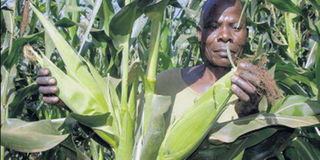Aflatoxin now fought with new technology

A farmer admires his healthy maize crop in his farm in Budalangi.
What you need to know:
- Individuals trained on technology called Nixtamalisation.
- Training took place at the Kenya Agricultural Research and Livestock Organization Centre in Katumani, Machakos.
- Further training on the programme to be rolled out to other regions affected by aflatoxin in the country.
A group of 27 individuals consisting of millers, engineers, agro-processing specialists and nutritionists have been trained on a new technology called nixtamalisation that expands the use of maize by up to 300 dishes and fights aflatoxin.
The technology majorly involves processing the maize while still wet through what is known as wet milling. The outer cover of the produce, which contains 50 percent of aflatoxin chemicals, is removed.
“The programme on nixtamilisation has great potential in significantly reducing the aflatoxin levels in maize,” said Dr Richard Lesiyampe, the Principal Secretary in the Department of Agriculture.
Other benefits of nixtamilisation include reduction in pellagra disease risk due to the improved niacin fibre by increasing resistant starch content in the food products and decreasing the levels of phytic acid, an inhibitor of iron and zinc absorption.
The Mexican trainers were led by ambassador Erasmo Martinez while the three-day training took place at the Kenya Agricultural Research and Livestock Organisation centre in Katumani, Machakos.
The Acting Chief Engineer, Department of Agriculture Engineering Services in the Ministry of Agriculture, Jasper Nkanya said the product from wet milling can be used to produce about 300 dishes.
Further trainings on the technology will be rolled out to all regions in the country, especially those areas which have significant infestation of aflatoxin.





